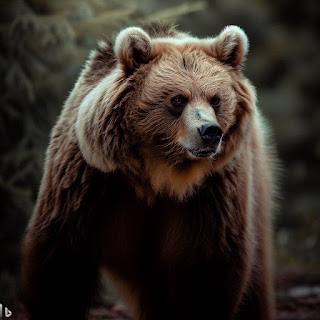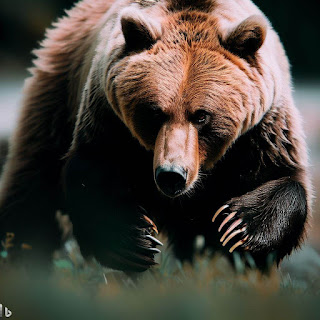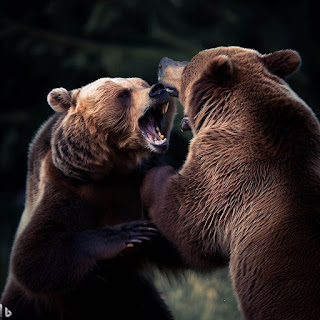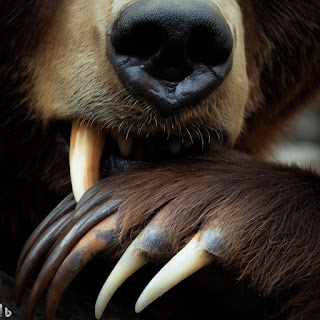Grizzly Bear introduction, kinds, territory, physical characteristics, Speed, LifeSpan, hunt, fight, mating, teeth, paw, attack, gesture period
Grizzly bears:
Introduction:
Grizzly bears (Ursus arctos horribilis) are majestic creatures found in North America. They are part of the brown bear species and are known for their strength, size, and distinctive humped shoulders. With their powerful presence and remarkable adaptability, grizzly bears have captivated the imagination of people around the world.
Kinds:
There are several subspecies of grizzly bears, including the Kodiak bear, which is the largest subspecies found on Kodiak Island in Alaska. Other subspecies inhabit different regions of North America, such as the coastal areas of British Columbia, the Rocky Mountains, and parts of the western United States.
Grizzly bears are primarily found in remote and rugged habitats, including forests, mountains, tundra, and grasslands. They have a wide distribution across North America, although their populations have diminished due to habitat loss and human encroachment.
Physical Characteristics:Weight:
Grizzly bears are large animals, typically weighing between 400 and 1,000 pounds (180 to 450 kilograms), although some individuals can exceed these weights. A grizzly bear's mass can shift according to factors like its subspecies, sexuality, and geographic location. A male grizzly bear weighing over 1,600 pounds was the heaviest ever documented.
|
Subspecies
|
Male
|
Female
|
|
Coastal grizzly
|
600-800 lbs
|
350-500 lbs
|
|
Interior grizzly
|
400-600 lbs
|
290-440 lbs
|
|
Kodiak bear
|
800-1,500 lbs
|
600-1,000 lbs
|
A grizzly bear's mass shifts from season to season, too. Bears lose weight in the spring and summer because they haven't started stuffing themselves for hibernation quite yet. Bears can pack on as much as 100 pounds in preparation for winter by eating voraciously in the fall.
Size and Height:
Grizzly bears range in size and height based on their subspecies, sexuality, and geographic location. Adult male grizzly bears can vary in size, but typically they are about 6 feet in length and 3 feet tall at the shoulder. The average female is roughly 5 feet in length and 2.5 feet in height at the shoulder.
A male grizzly bear measuring 8 feet in length and 4 feet in height at the shoulder was the largest of its kind to ever be documented.
|
Subspecies
|
Length
|
Height at Shoulder
|
|
Coastal grizzly
|
6-8 feet
|
3-4 feet
|
|
Interior grizzly
|
5-7 feet
|
2.5-3 feet
|
|
Kodiak bear
|
7-9 feet
|
3.5-4.5 feet
|
Q: What is the running speed of grizzly bear? or How fast can a grizzly bear run?
A: A grizzly bear can run as fast as 35 miles per hour (56 km/h). They are thought to be among the fastest animals on land in the Americas because of this. But at this speed, they can only go a certain distance. They often go about 25 miles per hour (40 kilometers per hour).
Grizzly bears' robust muscles and large, sharp claws allow them to run at high speeds. Their claws allow them to grab onto surfaces and even use it as propulsion. Their very efficient gait also aids in their ability to preserve energy.
Lifespan of Grizzly bears:
A wild grizzly bear can expect to live between 20 and 25 years. But there are reports of bears living for up to 35 years. Some grizzly bears kept in captivity have lived for more than 40 years.
Hunting:
Grizzly bears are omnivorous, meaning they have a diet that consists of both plant matter and meat. While their diet primarily consists of vegetation such as berries, nuts, grasses, and roots, they are also capable hunters. Grizzlies can smell and hear very well, which helps them find and catch their food, including fish, small mammals, and occasionally larger ungulates like elk or moose.
Fight:
Grizzly bears are solitary animals, and conflicts between individuals typically arise during mating season or when defending food resources. When faced with a threat, grizzlies can exhibit aggressive behavior, including charging, vocalizing, and even physical confrontations. They have formidable strength and sharp claws that can cause significant damage.
Mating Season:
The mating season for grizzly bears generally occurs in late spring or early summer. During this time, males compete for the attention of females by engaging in displays of strength and dominance. Once a male establishes dominance, he mates with receptive females.
Gestation Period:
The gestation period lasts around 6 to 8 months. Female grizzlies give birth to one to four cubs, usually in a den during the winter months.
Teeth and Claws:
Grizzly bears have long, curved claws that are adapted for digging, foraging, and catching prey. Their teeth are well-suited for their omnivorous diet, has pointy canines for slicing and shredding flesh and flat molars for pulverizing vegetables.
Paw and Attack:
Grizzly bears have large, powerful paws that can measure up to 12 inches (30 centimeters) in length. These paws are equipped with strong claws, which they use for various activities such as digging for food or constructing dens. In an attack, grizzly bears can deliver devastating blows with their paws and can cause severe injury due to their strength and sharp claws.
Bear in mind that grizzlies don't always act aggressively. If they feel endangered, then they will attack. Keep your cool and don't make any hasty moves if you come across a grizzly bear in the woods. If the bear attacks, use any means necessary to defend yourself.
It's important to note that grizzly bears are wild animals and should be respected from a safe distance. Interactions with grizzlies should be avoided to ensure the well-being of both humans and bears.
FAQ:
Q: Who is stronger polar bear or grizzly? or Who is the biggest bear? or polar bear vs grizzly bear.
A: Both polar bears and grizzly bears are formidable creatures, but when it comes to pure strength, the polar bear generally holds the title for being stronger.
Polar bears are the largest species of bear and have evolved to survive in the harsh Arctic environment. They have well-developed muscles, particularly in their forelimbs, which they use for swimming, climbing, and hunting. Adult male polar bears can weigh between 900 and 1,600 pounds (410 to 730 kilograms) and stand about 8 to 10 feet (2.4 to 3 meters) tall when on their hind legs.
Grizzly bears, on the other hand, are no slouches in terms of strength either. They are large, powerful bears and can be extremely aggressive when threatened. However, on average, grizzly bears are slightly smaller than polar bears. Adult male grizzlies typically weigh between 600 and 900 pounds (270 to 410 kilograms) and stand about 6 to 7 feet (1.8 to 2.1 meters) tall when on their hind legs.
Q: Are grizzly bears aggressive?
A: Bear in mind that grizzlies don't always act aggressively. If they feel endangered, then they will attack. Keep your cool and don't make any hasty moves if you come across a grizzly bear in the woods. If the bear attacks, use any means necessary to defend yourself.
Q: Why are grizzly bears famous?
A: Grizzly bears are famous for their Impressive Size and Strength, Majestic and Iconic Symbol, Intriguing Behavior and Habits, Conservation Status and Challenges, Cultural and Native American Significance, Pop Culture Representations, Tourism and Ecotourism.
Q: Which is bigger gorilla or bear? or Grizzly bear vs gorilla.
A: Bears are bigger than gorillas in general. On average, a male ape weighs between 350 and 450 pounds, while a male bear can weigh anywhere from 400 to 1,500 pounds.
This rule does not always hold true, though. The silverback gorilla is the biggest gorilla on Earth. It can weigh up to 500 pounds. And some bear types aren't very big. For example, the sun bear weighs only about 200 pounds.
So, is a gorilla or a bear bigger? It depends on what kind of bear and ape we're talking about. Bears are bigger than gorillas most of the time, but there are some exceptions.
Q: Which is Powerful tiger or bear? or Grizzly bear vs Tiger.
A: If a grizzly bear were to encounter a tiger, several factors would come into play, including the individuals' size, health, experience, and circumstances. Generally speaking, a tiger would have advantages in terms of agility, speed, and specialized hunting techniques, while a grizzly bear would possess greater size, strength, and physical endurance. It's important to note that actual encounters between grizzly bears and tigers are extremely rare, as they inhabit different parts of the world.
It's worth emphasizing that both grizzly bears and tigers are apex predators and should be respected as wild animals. It is always best to observe and appreciate them from a safe distance and in their natural habitats.











Post a Comment